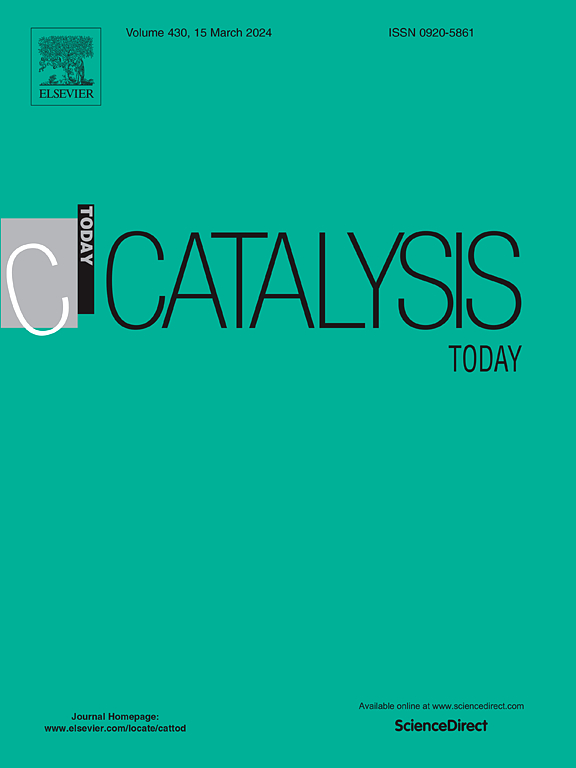Regulating CO2/H2O ratio of Ni-N-C single-atom catalysts through hydrophobicity engineering for acidic CO2 electroreduction
IF 5.2
2区 化学
Q1 CHEMISTRY, APPLIED
引用次数: 0
Abstract
Acidic electrolysis of CO2 has been considered as a promising route to inhibit carbonate formation, and enhances CO2 utilization efficiency. Suppressing hydrogen evolution reaction (HER) in the excessive H+ environment remains a considerable challenge, however, necessitating concerted efforts toward advanced catalysts and electrode designs to facilitate the CO2 diffusion. Herein, a Ni-N-C catalyst with a hydrophobic property (hydrophobic Ni-N-C) was synthesized as electrocatalyst for CO2 reduction, which showed a high faradaic efficiency of 98.9 % towards CO at 200 mA cm−2 compared to the hydrophilic Ni-N-C catalyst (77.8 %). Remarkably, when integrated into a gas diffusion electrode (GDE) in a flow cell, the hydrophobic Ni-N-C was capable of delivering carbon utilization up to 82.8 %, surpassing all of the other CO2 reduction electrocatalysts in alkaline electrolysis in the literature. Such outstanding performance could be contributed to the hydrophobic Ni-N-C with multiple three-phase interface, which provided superior gas-phase transfer channels for CO2 supply and impeded the H+-enriched on the catalyst surface, thus successfully suppressing the HER during the acidic CO2 electrolysis. This work may inspire further optimization of the wettability of catalyst electrode for electrochemical CO2 reduction and other gas consumption electrosynthesis in acidic electrolysis.
通过疏水工程调节Ni-N-C单原子催化剂在酸性CO2电还原中的CO2/H2O比
酸性电解CO2被认为是抑制碳酸盐岩形成和提高CO2利用效率的一种很有前途的途径。然而,抑制过量H+环境下的析氢反应(HER)仍然是一个相当大的挑战,需要共同努力开发先进的催化剂和电极设计来促进CO2的扩散。本文合成了具有疏水性的Ni-N-C催化剂(疏水性Ni-N-C)作为CO2还原电催化剂,在200 mA cm−2下,对CO的法拉第效率为98.9 %,高于亲水性Ni-N-C催化剂(77.8 %)。值得注意的是,当集成到流动电池中的气体扩散电极(GDE)中时,疏水Ni-N-C能够提供高达82.8 %的碳利用率,超过了文献中所有其他碱性电解中二氧化碳还原电催化剂。具有多三相界面的疏水Ni-N-C为CO2供给提供了优越的气相转移通道,阻碍了H+在催化剂表面的富集,从而成功抑制了酸性CO2电解过程中的HER。本研究为进一步优化酸性电解中电化学CO2还原和其他耗气电合成催化剂电极的润湿性提供了理论依据。
本文章由计算机程序翻译,如有差异,请以英文原文为准。
求助全文
约1分钟内获得全文
求助全文
来源期刊

Catalysis Today
化学-工程:化工
CiteScore
11.50
自引率
3.80%
发文量
573
审稿时长
2.9 months
期刊介绍:
Catalysis Today focuses on the rapid publication of original invited papers devoted to currently important topics in catalysis and related subjects. The journal only publishes special issues (Proposing a Catalysis Today Special Issue), each of which is supervised by Guest Editors who recruit individual papers and oversee the peer review process. Catalysis Today offers researchers in the field of catalysis in-depth overviews of topical issues.
Both fundamental and applied aspects of catalysis are covered. Subjects such as catalysis of immobilized organometallic and biocatalytic systems are welcome. Subjects related to catalysis such as experimental techniques, adsorption, process technology, synthesis, in situ characterization, computational, theoretical modeling, imaging and others are included if there is a clear relationship to catalysis.
 求助内容:
求助内容: 应助结果提醒方式:
应助结果提醒方式:


